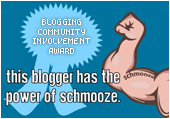Forgive my silence, folks. I've been tinkering with a sort-of new writing schedule per my conversation with
Miranda at
Creative Construction: not expecting to work during the day, getting most of it done at night. Some days it works better than others, and so I continue to tinker....
On to today's topic. On a parenting forum I belong to, we recently had a friendly debate over the best ways to "teach" art to 4-year-olds who don't seem very interested in it. I was surprised to see replies that told me (to paraphrase), "Art is about creative expression. You can't teach that, and you shouldn't try."
To some extent, I agree--for children who seem naturally inclined to express themselves artistically. For Hamlet, however, the issue is a little more complicated. He's a literal kid who needs to be led. He wants to know how to do things, but he also wants to be able to master them right from the get-go. (He is his mother's son.) And when we sit down to paint or color together, he often ends up watching me--or finding something else to do.
Not that I'm any Van Gogh. But I do paint pictures rather than scribbles: a moonlit field, a blooming cactus (all in tempera, mind you). Having decided he "can't," Hamlet seems interested in learning, but not trying.
Back to the debate. I worried that my pictures somehow stifled his desire to create, to scribble something on paper and declare it a mosquito or a volcano. It was disheartening to find that my friends agreed with my fear. And yet, I wondered, was there a way for me to teach Hamlet some sort of basics--the structure he could then break through to create whatever he wanted?
Because at that point, I wasn't just thinking about him and me. I was thinking about the pervasive teaching that says "creativity" is all that matters, not spelling or grammar or punctuation, or even story structure. (See
this article for an interesting perspective on the opposite end of the spectrum. Despite NCLB, Rain Dog continues to see papers that have no sense of structure or rules--but of course, his students were in elementary school before NCLB. I hope teachers are achieving better balance as my boys get ready to enter school.)
The creativity-first argument makes even more sense when viewed in light of genre, and literary, purists who sneer at blurred lines.
A spec fiction author can't write crime fiction; romance writers must retain their credibility
only by following strict guidelines. And the artists rebel.
But those are arbitrary rules, not fundamentals of language. When our words don't make sense to those who read them, then we fail to communicate. And, while true that the work of abstract artists is sometimes hard to interpret, even those artists first learned the rules before they broke them.
One mother suggested helping Hamlet practice basic shapes. Ah, I thought. His
Ice Age: The Meltdown video has a short bonus segment in which animator
Peter de Seve describes how he uses basic shapes to draw Sid. For my literal kid, that may be just what he needs.


